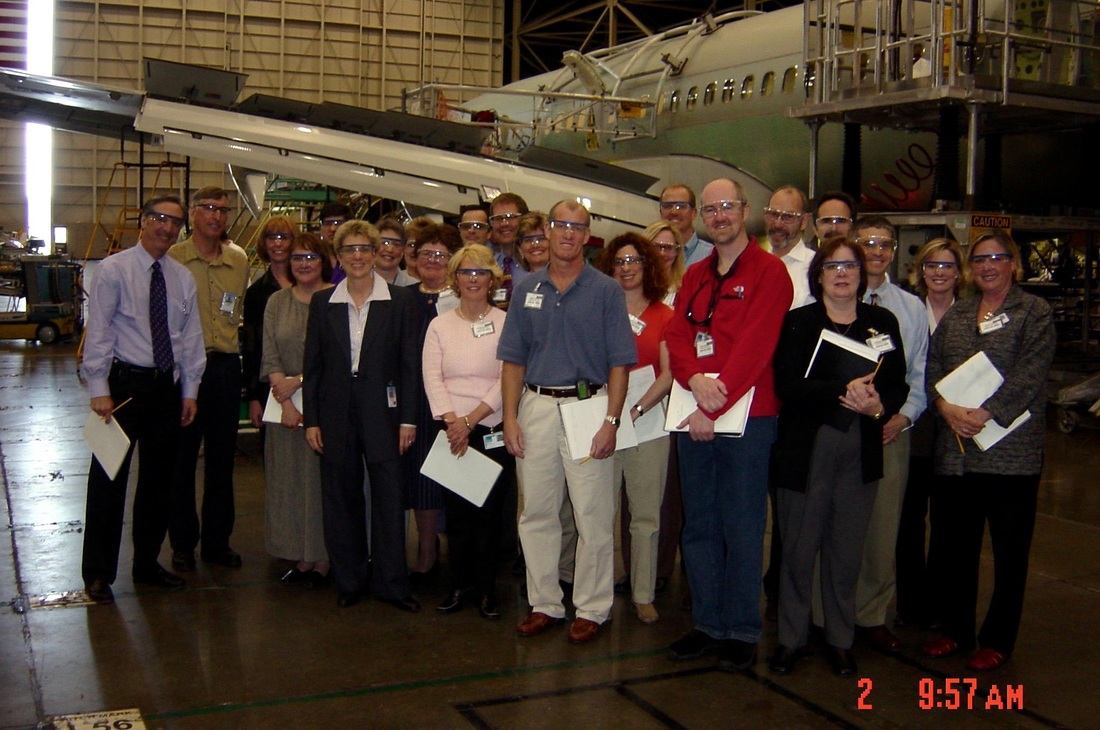When I first approach healthcare leaders about Lean, I’m often met with skepticism. Sometimes their questions center on a version of the following:
How can a system developed for Japanese auto-manufacturing, then advanced by Boeing for American plane manufacturing, possibly have relevant application in healthcare systems worldwide?
The connections seem far-fetched at first, but the power of Lean is that it is more than a narrow set of instructions; lean is an adaptable process for effecting organizational transformation regardless of the industry. Lean originated in Japan with the Toyota Production System, but its approach provides a universal roadmap to improvement. To illustrate the dynamic possibilities of lean, let’s look at the career of Carolyn Corvi, who led the adaptation of the Toyota Production System into the Boeing Production System and subsequently led and influenced transformations in the healthcare field.
By the 1980s, wasteful practices crept into Boeing’s production line. Leadership at Boeing, including Corvi, looked to Japan’s booming economy for answers.
How can a system developed for Japanese auto-manufacturing, then advanced by Boeing for American plane manufacturing, possibly have relevant application in healthcare systems worldwide?
The connections seem far-fetched at first, but the power of Lean is that it is more than a narrow set of instructions; lean is an adaptable process for effecting organizational transformation regardless of the industry. Lean originated in Japan with the Toyota Production System, but its approach provides a universal roadmap to improvement. To illustrate the dynamic possibilities of lean, let’s look at the career of Carolyn Corvi, who led the adaptation of the Toyota Production System into the Boeing Production System and subsequently led and influenced transformations in the healthcare field.
By the 1980s, wasteful practices crept into Boeing’s production line. Leadership at Boeing, including Corvi, looked to Japan’s booming economy for answers.
 Carolyn Corvi leads a tour of Boeing's 737 production line for executives at Virginia Mason Medical Center. In implementing lean, Corvi learned that the best leaders are teachers.
Carolyn Corvi leads a tour of Boeing's 737 production line for executives at Virginia Mason Medical Center. In implementing lean, Corvi learned that the best leaders are teachers.
Corvi introduced the concepts of Toyota’s moving line first at Boeing’s Propulsion Systems Division, and later to 737 airplane assembly. A meeting with Sensei Nakao, then President of Shingijutsu Co, LTD, as well as travels to Japan introduced Corvi to the innovative approaches at the Toyota factory. There, leaders acted as coaches, harnessing the full capacity of their workers’ abilities and inspiring their teams to continuously improve. Corvi was impressed with the technical genius of Toyota’s system and immediately saw possibilities for revolutionizing Boeing’s production line.
As Corvi adapted the methods of Toyota’s moving line to Boeing’s Propulsion Systems Division, the changes closed the gap between engineers and workers on the ground. This new system required a skillfully guided shift in company culture that revolutionized employee communication and collaboration. Corvi’s work made a significant contribution to Boeing’s reduction of factory cycle time by 46 percent and reduced defects of 90 percent. Boeing’s product quality went up as their costs went down.
Boeing’s success adopting and adapting the Toyota Production System (TPS) inspired Corvi to apply lean principles to another industry: healthcare. Just as successful plane manufacturing produces quality, defect-free jets, healthcare facilities’ strive to provide quality, mistake-free care to patients. In 2001, Corvi joined the board at Virginia Mason Medical Center (VMMC) where executive leadership had committed to adopt the Toyota Production System both at the hospital and throughout the entire health system. VMMC leaders visited the Boeing factory and began to learn how to apply TPS to transform employee communication and operations across all levels of patient care. TPS resulted in greater transparency and commitment to continual improvement in the patient care system, both cutting costs and leading to healthier and happier patients.
Lean’s applications are truly endless as long as the leadership is committed to seeing the process through. In Corvi’s words, “Lean is not a manufacturing tactic or a cost reduction initiative. It’s a management system that applies to all organizations. It requires courage, conviction, willingness to take risk and a ‘leap of faith’.” (Corvi 2010).
No matter what industry you’re in, I encourage you to set your vision for what your organization can achieve. Chances are you’ve already got the people in place to make your vision a reality, and applying Lean methods will enable the changes needed to make best use of the personnel and facility resources you already have.
Want to learn more about Corvi's Lean education? Click here.
Sources:
Black, John R. 2008. Lean Production: Implementing a World Class Production System, Industrial Press, Inc.
Black, John R. 2015. The Toyota Way to Healthcare Excellence, 2nd ed. Health Administration Press.
Corvi, Carolyn. Personal interview with John Black. February 15, 2015.
Corvi Carolyn. Presentation to Siemens Corporation. 2010.
Dec 2004/Jan 2005. High Speed Performance, In Boeing Frontiers Magazine, vol 3, issue 8 available online at http://www.boeing.com/news/frontiers/archive/2004/december/i_ca1.html
Black, John R. 2008. Lean Production: Implementing a World Class Production System, Industrial Press, Inc.
Black, John R. 2015. The Toyota Way to Healthcare Excellence, 2nd ed. Health Administration Press.
Corvi, Carolyn. Personal interview with John Black. February 15, 2015.
Corvi Carolyn. Presentation to Siemens Corporation. 2010.
Dec 2004/Jan 2005. High Speed Performance, In Boeing Frontiers Magazine, vol 3, issue 8 available online at http://www.boeing.com/news/frontiers/archive/2004/december/i_ca1.html


 RSS Feed
RSS Feed